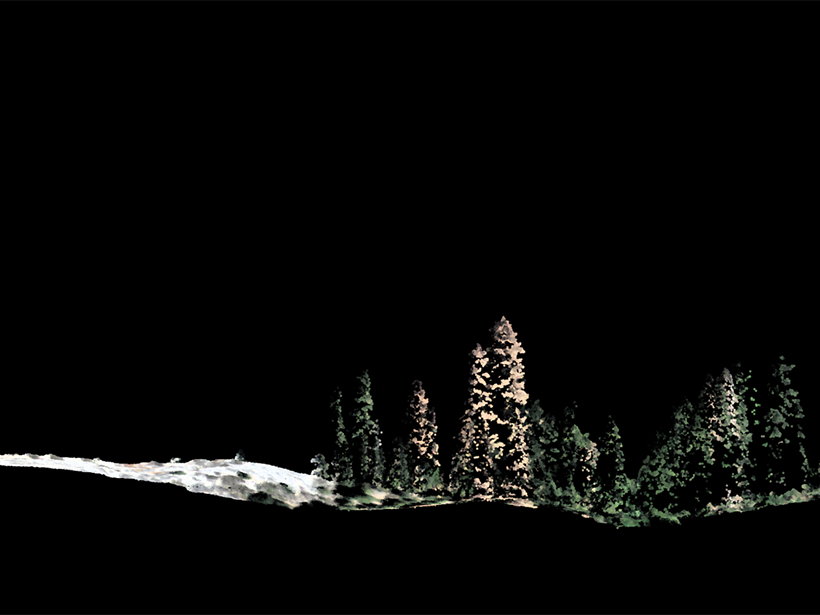Every year, millions of people flock to see the giant trees in California’s Sequoia and Kings Canyon National Parks and Redwood National and State Parks.
“It’s just emblematic of what people value. People value big, old trees,” said Nate McDowell, an Earth scientist at the Pacific Northwest National Laboratory in Richland, Wash.
Unfortunately, climate change puts these large trees at increased risk. “In the future, we might see droughts become more severe and more frequent,” said Xi Yang, an environmental scientist at the University of Virginia in Charlottesville.
Yang was the senior researcher on a study recently published in Nature Communications that reported that taller trees died at more than twice the rate of smaller trees at the end of extreme drought. “Of the trees above 30 meters tall, nearly half of them died during this study. Which is a staggering number,” said lead researcher Atticus Stovall.
Tracking a Tree’s Death from the Air
The researchers were able to track the mortality of 1.8 million trees in California from 2009 to 2016 in an area spanning over 40,000 hectares—roughly the size of Denver—using lidar measurements taken from an aircraft. Lidar is akin to radar but uses shorter wavelength laser light instead of radio waves to determine the distance of a target.
From an airplane cruising at 1,000 meters, lidar has a vertical resolution on the order of centimeters, Stovall said. “You can see birds in lidar data sets, which is really crazy.”
With this level of granularity, researchers could identify individual trees and assess mortality across the landscape. “There’s no two same trees in the world,” Yang said.

Being able to track individual trees is important for understanding what biological or environmental factors drive its functioning. “This, to my knowledge, is the first study that has taken individual tree mapping and linked it with trends in mortality like this,” Stovall said.
Using lidar allowed researchers to survey a much larger landscape than previous studies, said McDowell, who was not involved with the study. Traditionally, scientists on the ground would survey plots of forest to monitor tree health. Although these plot measurements are robust, they miss the entirety of the forest for all the trees in it.
Case in point: There were only about 17 trees that were taller than 70 meters in the entire data set. “Statistically speaking, you would almost never find those trees in that 40,000 hectares,” Stovall said. “If you found one of those trees, it would be like you hit the jackpot.”
The Bigger They Are, the Harder They Fall
Although tree height was the strongest predictor of tree mortality, environmental factors like water and competition also played a role. Another primary risk factor was the vapor pressure deficit (VPD). The higher the VPD, which is associated with higher temperatures and lower humidity, is, the more prone trees are to drying out and dying.
“Something I feel is really important for the public to understand is that things aren’t going to get better. In their lifetimes, things won’t get better. Things will only get worse, especially for big trees.”
Large trees died at even higher rates when the VPD was high. “In a way, a lot of it is physics,” Stovall said. The tree’s xylem is like a straw, he said, and large trees require larger straws to move more water from roots to the leaves. The stress of a drought likely makes these trees more susceptible to cavitation, “which is literally a column of water within that straw that I was describing being ripped apart,” said Stovall. The air bubble that forms in the water column “renders the entire water transport system useless—it’s pretty dramatic.”
For McDowell, the data showing the role VPD played in tree mortality were particularly striking. “Something I feel is really important for the public to understand is that things aren’t going to get better,” he said. “In their lifetimes, things won’t get better. Things will only get worse, especially for big trees.”
And what is bad for large trees is bad for the environment as a whole.
“They hold and filter tons of water,” Stovall said. “They’re literally sequestering carbon, so they’re helping us out there, too.”
McDowell agreed: “It’s the big old trees that store the most carbon. And we need that to mitigate climate warming.” Loss of these large trees would likely exacerbate global climate emissions.
There are short-term management strategies for preserving large trees, like clearing smaller trees to reduce competition for water, but “they’re a Band-Aid, they’re not a cure,” McDowell said.
In the end, saving the large trees “comes down to the hard things that everyone is well aware of,” Stovall said.
“You know, I don’t want to tell people how to live their lives,” Stovall continued. “But the science here is really pointing towards this reality that the decisions that everyday people make in terms of emissions and carbon footprint and everything really do have large-scale effects on the environment.”
—Richard J. Sima (@richardsima), Freelance Science Writer
20 November 2019: This article has been corrected to clarify the description of lidar.
Citation:
Sima, R. J. (2019), The bigger they are, the harder they fall, Eos, 100, https://doi.org/10.1029/2019EO135705. Published on 18 October 2019.
Text © 2019. The authors. CC BY-NC-ND 3.0
Except where otherwise noted, images are subject to copyright. Any reuse without express permission from the copyright owner is prohibited.

